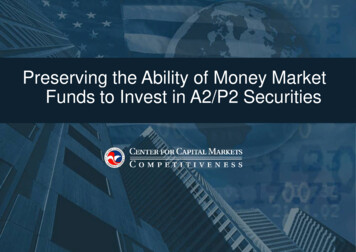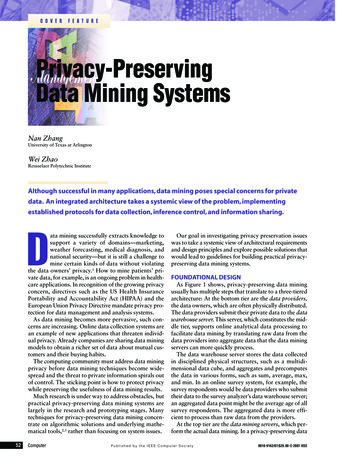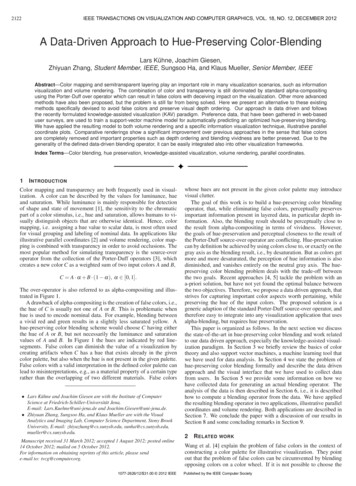
Transcription
Preserving the AbilityAbility of Money MarketFunds to Invest in A2/P2 Securities
Outline1.2.CHALLENGING THE BASIS FOR THE PROPROPPOSEDOSED PROHIBITIONA.Examining the SEC’s Analysis and CCoonclusionsnclusionsi.Size of the market – 46.8 billionbillion is an important source of financing for many majorU.S. companiesA2/P2 credit spreads to widen in Fall 2008ii.Credit spreads – CPFF caused A2/P2iii. Risk reduction – The proposed prohibitionprohibition would not have prevented the events ofSeptember 2008B.Additional Factors to ConsiderBackstop credit facilities – 100%% backstop credit facilities are required for the A2/P2i.rating, but not for A1/P1ii.Default risk – Default risk of A1/A1/PP11 is very similar to A2/P2iii. Reliance on ratings - Transition rates between the top two tiersNEGATIVE AND UNINTENDED CONSEQUECONSEQUENCESNCES OF THE PROPOSED PROHIBITIONA.B.C.D.Diversification – Reduced ability to divediversify 2a-7 portfoliosImpact on capital formation – DecreaseDecreasedd flexibility and increased costsDomino effect – Impact of an SEC bebennchmarkchmark prohibiting investment in A2/P2Impact on bank lending – A2/P2 comcomppaniesanies drawing down their credit facilities would reduce2the ability of banks to lend to other partpartss of the economy2
SEC proposal: the size of the A2/P2 market “has remained consistentlyconsistently small over time.” 46.8 billion is an important source of finafinancingncing for many major U.S. companiesA2/P2 Issuers 204 companies 4 million employees 2 trillion in revenue 1 trillion in market capitalizationIssuerCVS/Caremark Corp.Devon Energy Corp.Safeway, Inc.Clorox CompanyCloroxCompanyAlcoa, Inc.Dominion ResourcesComcast Corp.Outstandings ( mm)1,6061,33062653852037987Source:Source: Public filings and Bloomberg. Data reported at end of Q2 FYE 200933
Although A2/P2 securities represent onlonlyy a realtively small portion of total CP7 funds represent a significant source of financing forheld by all funds, 2a-7individual corporate CP programsCorporate IssuerPercentagePercentage of CP Program Financed by 2a2a-7 Funds*Comcast80%CVS Caremark30%Devon Energy20%*This amount fluctuates over time, figure indicates the maximum percperceentage in the last year44
SEC proposal: A2/P2 securities present “potentially substantially more risk than first tier securities.”The CPFF caused A2/P2 credit spreads to widenFed announcesCPFF – excludesA2/P2 Issuers(b 07Oct-07AA Financial Spread to 1 mo LIBORSource: Federal Reserve. Spread to 1-month LIBOR.Mar-08Aug-08A2/P2 Corporate Spread to 1 mo LIBORJan-09Jun-09AA Corporate Spread to 1 mo LIBOR5
The proposed prohibition would not have prevented theevents of September 2008Lehman Brothers was an issuer of AA-1 commercial paper up until the Lehmanday it filed for bankruptcy. MostMost commercial paper defaults have resulted from unforeseenliquidity events, which is a risk equally applicable to A1/P1 Issuers. TheThe commercial paper market is generally efficient in removingweaker companies from the market in an orderly manner prior to anymaterial credit deterioration.6
A2/P2 Issuers: 100% Backstop Credit Facilities are Requiredto Maintain Rating CreditCredit rating agencies require A2/P2 issuers to have 100%backstop facilities for their commercial paper programs in order tomaintain the investment grade A2/P2 rating. ThisThis means that a disruption in the commercial paper market willnot automatically force a default on the paper as the issueralready has alternative financing pre--arranged. TheThe slightly higher default rate between A1/P1 Issuers and A2/P2Issuers is more than compensated for by the incremental yield paidby A2/P2 Issuers.7
SEC proposing release did not examine historic default rates for commercial paperA2/P2 Default Risk is Very Similar to A1/P1180 Day Corporate Commercial Paper Default Rate 1972 – Content.ashx?source cuments/st corp and struc transition rates 06 07.pdf8
Short-termterm rating transition rates between the top two tiers –The SEC should not increase reliance on ratings under 2a-72a as it works to decrease reliance in other areas3.00%180 Day Corporate Commercial Paper Transition Rates 1972 – 20062.50%2.00%1.50%P-1 to P-21.00%P-2 to P-10.50%0.00%30 days60 days90 days120 days180 ent.ashx?source cuments/st corp ?source cuments/st corp and struc transition rates 06 07.pdf9
Proposal increases reliance on credit ratings Overreliance on credit ratings contributedsignificantly to recent economic events This proposal runs counter to other SECrulemaking initiatives seeking to reduce relianceon credit ratings10
“Domino effect” on non-2a72a7 money: The SEC Benchmark ManyMany cash managers for insurance companies, corporations,municipalities, high net worth individuals, and other investors useRule 2a-77 as a guideline for investment practices. Managers of non-2a-77 assets may use the Proposed Prohibition asa benchmark for best practices and further limit or eliminate theirholdings of A2/P2 Securities. ThisThis could result in a domino effect that could quickly constrict themarket for A2/P2 Securities.11
Reduced Ability to Diversify 2a-77 Portfolios: The proposed prohibitionwould cut the pool of potential issuers by 43%A2/P243%A1/P157%Data reported at end of Q2 FYE 200912
Reduced Ability to Diversify 2a-77 Portfolios:A1/P1 vs. A2/P2 - Financials v. al18%Financial51%Non-financial82%Data reported at end of Q2 FYE 200913
“Domino effect” on non-2a72a7 money: Analyst Coverage Many firms manage both 2a--7 and non-2a-7 moneyfor cash management vehicles. When they can invest in A2/P2 Securities, there areefficiencies that can justify the cost of credit analystscovering A2/P2 Securities as the paper could be heldby both the 2a-7 and non-2a--7 accounts. Prohibiting the ability of investment companies toinvest 2a-77 money in A2/P2 Securities could reducethese efficiencies and force firms to restrict analystcoverage and all of their investments to A1/P1Securities.14
Impact on capital formation:Decreased Flexibility and Increased Costs Greater flexibility in financing through 2a2a-7investment vs. bank loans The recent economic downturn has severely limitedthe ability of banks to make these types of loans The increased cost of capital could negatively affectinvestors in these companies and consumers inthese industries15
Negative Impact on Bank LendingThe Proposed Prohibition could drive A2/P2 Issuers todraw down their credit facilities which would negativelyimpact the ability of banks to lend to other parts of theeconomy.16
Joint Signatories: September 3 Letter* Urging SEC to PreserveAbility of Money Market Funds to Invest in A2/P2 Securities Aetna, Inc. Alcoa Avon Clorox Corp. Comcast Consolidated Edison CVS/Caremark Devon EnergyCorporation Dominion Resources U.S.U.S. Chamber of CommerceCenter for Capital MarketsCompetitiveness NationalNational Association ofCorporate Treasurers FinancialFinancial ExecutivesInternational AssociationAssociation for FinancialProfessionals ManufacturedManufactured HousingInstitute Hubbell Inc. Marriott International Nissan Motor AcceptanceCorporation Pacific Gas and Electric Safeway Inc. The Service Master Co. The Walt DisneyCompany Time Warner Duke Energy Time Warner Cable FMC Corporation XTO Energy17*JointJoint Letter resubmitted on September 23 with additional signatures
nsistently small over time." ncing for many major U.S. companies urce: Public filings and Bloomberg. Data reported at end of Q2 FYE 2009 SEC proposal: the size of the A2/P2 market "has remained 46.8 billion is an important source of fin orox ompany 3 SEC proposal: the size of the A2/P2 market "has remained co










